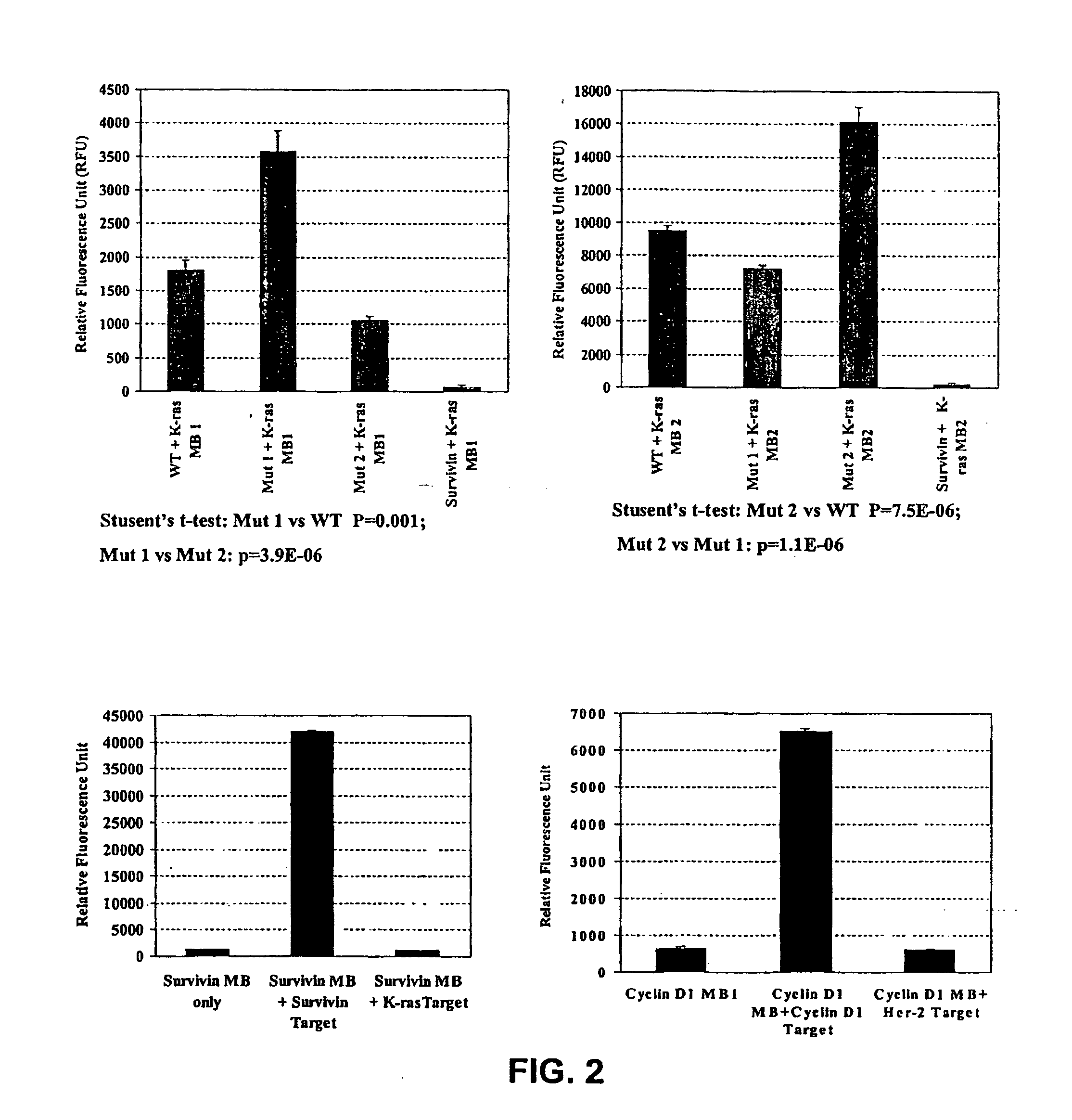Methods of detecting gene expression in normal and cancerous cells
- Summary
- Abstract
- Description
- Claims
- Application Information
AI Technical Summary
Benefits of technology
Problems solved by technology
Method used
Image
Examples
example 1
Preliminary Detection of Survivin Gene Expression in Breast Cancer Cell Lines Using Survivin MB
[0068] MBs specific for human survivin gene were designed and synthesized, with the probe sequence complementary to the cDNA sequence between 27 nt to 43 nt of the gene (5′-Alexa-fluo 488-CTGAGAAAGGGCTGCCAGTCTCAG-Dabcyl-3′; SEQ ID NO:1). The underlined stem sequences of survivin MB is specially designed to achieve the best thermodynamic effect. At first, specific hybridization of survivin MB was studied with a synthesized survivin oligonucleotide target in vitro.
[0069] Results indicated that the survivin MB binds specifically to survivin targets (FIG. 2 C). The specificity of survivin MBs for detecting survivin mRNA was further examined in the breast cancer cell lines MDA-MB-231, MDA-MB-435 and MCF-7 expressing different levels of survivin gene and in normal human mammary epithelial cell line (MCF-10A). After incubation of survivin MBs with fixed cells at 37° C. for 1 hour, the cells we...
example 2
Simultaneous Detection of Expression of Survivin and Cyclin D 1 in Breast Cancer Cells
[0070] Further studies were carried out to examine the specificity of detection of cancer cells with several tumor marker MBs. MBs for cyclin D 1 and Her-2 / neu genes were designed and synthesized (Table 1). Inventors then examined the specificity of the MBs in vitro with synthesized olignucleotide targets. The sequences for each MB are shown in the Table 1. The underlined sequences are not part of the gene and are designed to form the stem. Inventors have also synthesized a several survivin MB with the same sequences as with different fluorescence dyes (6-FAM, Cy3, Alexa-Fluo-488). Survivin MB-FITC has a different target sequence as shown in the Table 2. The MBs were synthesized by MWG Biotech (High point, N.C.) and Integrated DNA Technologies, Inc. (IDT, Coralville, Iowa).
[0071] To determine specific hybridization of the MBs with their targets, hybridization studies were carried out by mixing t...
example 3
Identification of Survivin Expressing Cells in Primary Breast Cancer Tissues
[0073] To investigate the feasibility of using survivin as a breast cancer marker, the expression of survivin proteins in paired and non-paired normal and breast cancer tissues by Western blot analysis was examined. It was found that that survivin is expressed in over 73% of breast cancer tissues but not in any of the normal breast tissues FIG. 10). Immunofluorescence staining of frozen tissue sections with survivin antibody also revealed that survivin is highly expressed in invasive ductal carcinoma cells but not in normal breast ductal cells (FIG. 5A). Interestingly, the lesions of DCIS also showed intermediate level of survivin (FIG. 5A). Examination of survivin gene expression on frozen tissue sections using survivin MBs further revealed survivin-expressing cancer cells in DCIS lesion, invasive ductal carcinoma, and metastases in draining lymph node of a breast cancer patient. However, there were no su...
PUM
| Property | Measurement | Unit |
|---|---|---|
| Gene expression profile | aaaaa | aaaaa |
Abstract
Description
Claims
Application Information
 Login to View More
Login to View More - R&D
- Intellectual Property
- Life Sciences
- Materials
- Tech Scout
- Unparalleled Data Quality
- Higher Quality Content
- 60% Fewer Hallucinations
Browse by: Latest US Patents, China's latest patents, Technical Efficacy Thesaurus, Application Domain, Technology Topic, Popular Technical Reports.
© 2025 PatSnap. All rights reserved.Legal|Privacy policy|Modern Slavery Act Transparency Statement|Sitemap|About US| Contact US: help@patsnap.com



